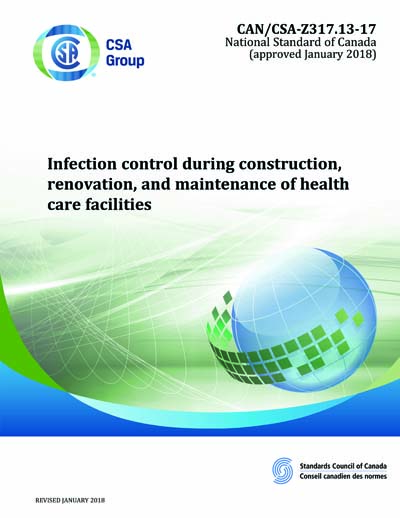Historical
CSA Z317.13-2017
Z317.13-17 - Infection control during construction, renovation, and maintenance of health care facilities
Preface
This is the fourth edition of CSA Z317.13, Infection control during construction, renovation, and maintenance of health care facilities. It supersedes the previous editions, published in 2012, 2007, and 2003. It is part of a series of Standards related to health care facility engineering and sets forth preventive measures intended to protect patients, staff, and visitors from disease transmission and other health problems, such as allergic reactions, that can be produced by the construction, renovation, or maintenance of health care facilities. The first edition of this Standard was based on Construction-related Nosocomial Infections in Patients in Health Care Facilities: Decreasing the Risk of Aspergillus, Legionella and Other Infections, published by Health Canada in 2001. Changes to this edition include the following: a) new and revised requirements for cleaning of construction sites and building components, both during and after construction; b) expanded new requirements for wall materials and design in areas subject to moisture; c) updated requirements for monitors and alarms to maintain relative pressurization at construction sites; d) reorganization of the existing annexes, and creation of new informative annexes to provide sample checklists and additional guidance; e) revised clauses on the use of the building's HVAC system for air supply to construction areas; f) revised requirements for cleaning and testing of construction air handling units (CAHUs) between uses; g) new requirements to prevent contamination of water systems during construction activities; h) additional requirements around orientation and training of personnel working on construction sites; i) additional information on roles and responsibilities of infection prevention and control personnel and the MDT; and j) new and revised requirements for post-construction evaluation and documentation. CSA Group acknowledges that the development of this Standard was made possible, in part, by the financial support of the governments of Alberta, British Columbia, Manitoba, New Brunswick, Newfoundland and Labrador, Northwest Territories, Nova Scotia, Nunavut, Ontario, Prince Edward Island, Québec, Saskatchewan, and Yukon, as administered by the Canadian Association for Drugs and Technology in Health (CADTH).Scope
1.1 This Standard specifies precautionary and remedial measures, including quality system requirements, for preventing exposure to agents released or augmented because of actions undertaken during health care facility construction, renovation, maintenance, and repair work. 1.2 This Standard is intended to apply to the activities of the following individuals or groups in relation to any aspect of construction, renovation, maintenance, or repair of health care facilities: a) commissioning teams; b) constructors; c) infection prevention and control personnel; d) architects, engineers, and other design and construction consultants; e) planning and project managers; f) facility managers and maintenance managers; g) environmental services staff; h) health care staff; i) occupational health and safety professionals; and j) operation and maintenance staff. 1.3 This Standard applies to all types of health care facility construction projects, no matter what construction delivery method is used (e.g., stipulated sum, public-private partnership). 1.4 This Standard has been developed for use during the project specification phase of construction, renovation, and maintenance and repair projects, and to assist in preventing and controlling fungal and bacterial infections during the implementation of such projects. 1.5 In this Standard, shall is used to express a requirement, i.e., a provision that the user is obliged to satisfy in order to comply with the Standard; should is used to express a recommendation or that which is advised but not required; and may is used to express an option or that which is permissible within the limits of the Standard. Notes accompanying clauses do not include requirements or alternative requirements; the purpose of a note accompanying a clause is to separate from the text explanatory or informative material. Notes to tables and figures are considered part of the table or figure and may be written as requirements. Annexes are designated normative (mandatory) or informative (non-mandatory) to define their application.Content Provider
CSA America, Inc. [csa]






